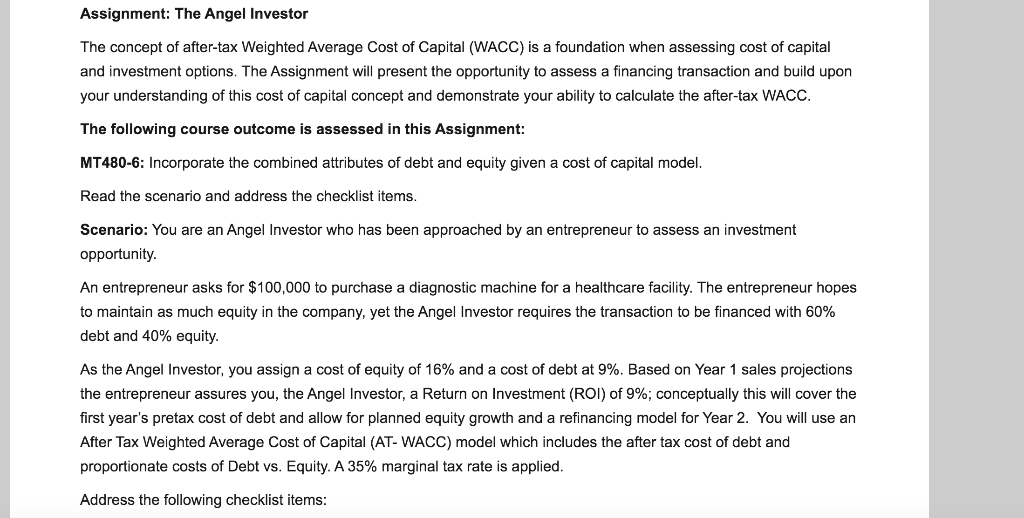

Assignment: The Angel Investor The concept of after-tax Weighted Average Cost of Capital (WACC) is a foundation when assessing cost of capital and investment options. The Assignment will present the opportunity to assess a financing transaction and build upon your understanding of this cost of capital concept and demonstrate your ability to calculate the after-tax WACC. The following course outcome is assessed in this Assignment: MT480-6: Incorporate the combined attributes of debt and equity given a cost of capital model. Read the scenario and address the checklist items. Scenario: You are an Angel Investor who has been approached by an entrepreneur to assess an investment opportunity An entrepreneur asks for $100,000 to purchase a diagnostic machine for a healthcare facility. The entrepreneur hopes to maintain as much equity in the company, yet the Angel Investor requires the transaction to be financed with 60% debt and 40% equity. As the Angel Investor, you assign a cost of equity of 16% and a cost of debt at 9%. Based on Year 1 sales projections the entrepreneur assures you, the Angel Investor, a Return on Investment (ROI) of 9%; conceptually this will cover the first year's pretax cost of debt and allow for planned equity growth and a refinancing model for Year 2. You will use an After Tax Weighted Average Cost of Capital (AT- WACC) model which includes the after tax cost of debt and proportionate costs of Debt vs. Equity. A 35% marginal tax rate is applied. Address the following checklist items: Checklist: Explain the tax benefits of debt financing. Calculate the AT- WACC with a 60% debt and 40% equity financing structure. Apply the calculated AT-WACC to explain why this is or is not a viable investment for you as the Angel Investor. Explain a financial restructuring AT-WACC (given changes to proportions of % Debt vs. % Equity financing) that would create a positive ROI. Explain why you as the Angel Investor would require more or less debt vs. equity financing. Be sure to note the role of the Unified Commercial Code-1 (UCC-1) document in this transaction and the order of claim on assets in times of a bankruptcy. hmit von anane in a minimum af nogo APA formatted Microsoft document to the Dronhay with Assignment: The Angel Investor The concept of after-tax Weighted Average Cost of Capital (WACC) is a foundation when assessing cost of capital and investment options. The Assignment will present the opportunity to assess a financing transaction and build upon your understanding of this cost of capital concept and demonstrate your ability to calculate the after-tax WACC. The following course outcome is assessed in this Assignment: MT480-6: Incorporate the combined attributes of debt and equity given a cost of capital model. Read the scenario and address the checklist items. Scenario: You are an Angel Investor who has been approached by an entrepreneur to assess an investment opportunity An entrepreneur asks for $100,000 to purchase a diagnostic machine for a healthcare facility. The entrepreneur hopes to maintain as much equity in the company, yet the Angel Investor requires the transaction to be financed with 60% debt and 40% equity. As the Angel Investor, you assign a cost of equity of 16% and a cost of debt at 9%. Based on Year 1 sales projections the entrepreneur assures you, the Angel Investor, a Return on Investment (ROI) of 9%; conceptually this will cover the first year's pretax cost of debt and allow for planned equity growth and a refinancing model for Year 2. You will use an After Tax Weighted Average Cost of Capital (AT- WACC) model which includes the after tax cost of debt and proportionate costs of Debt vs. Equity. A 35% marginal tax rate is applied. Address the following checklist items: Checklist: Explain the tax benefits of debt financing. Calculate the AT- WACC with a 60% debt and 40% equity financing structure. Apply the calculated AT-WACC to explain why this is or is not a viable investment for you as the Angel Investor. Explain a financial restructuring AT-WACC (given changes to proportions of % Debt vs. % Equity financing) that would create a positive ROI. Explain why you as the Angel Investor would require more or less debt vs. equity financing. Be sure to note the role of the Unified Commercial Code-1 (UCC-1) document in this transaction and the order of claim on assets in times of a bankruptcy. hmit von anane in a minimum af nogo APA formatted Microsoft document to the Dronhay with








